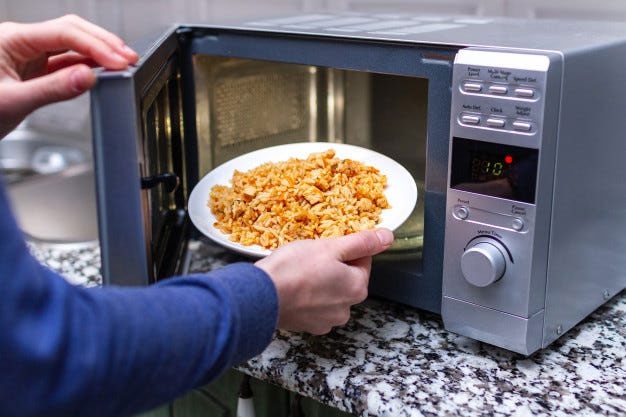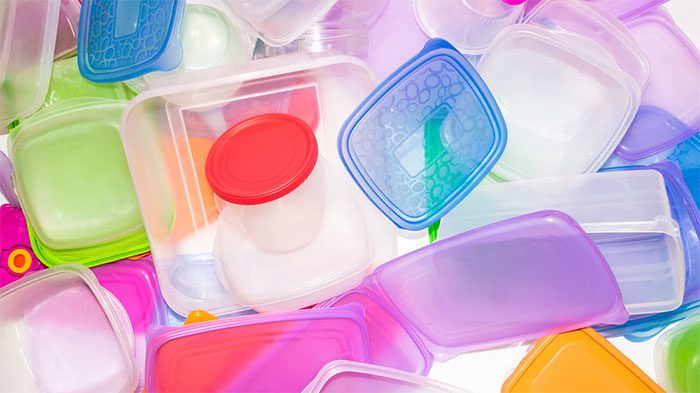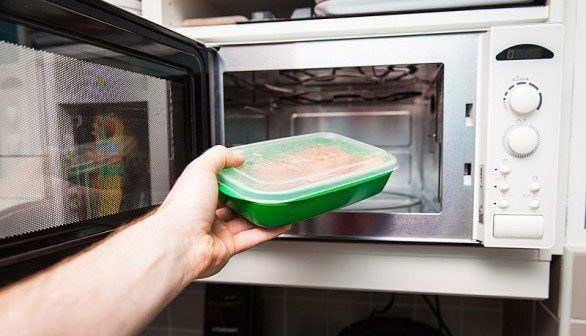Office workers often have the habit of using microwaves to reheat their plastic lunch boxes. This practice is releasing billions of microplastics into food.
Should You Microwave Plastic?
Plastic is a material present in every aspect of daily life. The diverse technology used to produce plastic offers convenience for various purposes, but it raises significant health concerns when used for food storage.
According to Bon Appétit, researchers have recently discovered that the most harmful combination is using plastic with microwaves. Office workers commonly heat food in plastic containers without realizing the potential health effects.
In a recent serendipitous finding, Kazi Albab Hussain, a PhD student at the University of Nebraska–Lincoln, was studying silver nanoparticles released from certain types of plastic food packaging when he noticed a substance resembling “microplastics” under the microscope, which are essentially tiny plastic fragments.
As a new father, Hussain is particularly concerned about this, especially since many foods for children are stored in plastic. He shifted his research focus to understand: How many of these particles might my child be consuming?
According to his findings, the number could reach billions. Hussain brought several reusable polypropylene plastic containers and a reusable polyethylene plastic food bag into the research lab.
He filled the containers with water and 3% acetic acid to simulate real-life food containing water and acid.
After storing the containers in the refrigerator or at room temperature for 10 days, the research team found millions to billions of microplastic and nano-plastic particles in the liquid.

We are consuming more plastic than we ever thought.
But what’s even more alarming is that microwaving these containers accelerated this process: Within three minutes, some containers released up to 4.22 million microplastic particles (smaller than 5 mm) and 2.11 billion nano-plastic particles (approximately 70 times smaller than the width of a human hair) per square centimeter of surface area.
Hussain’s research indicates that we are consuming more plastic than previously thought. A study in 2019 estimated that we could be ingesting around 50,000 microplastic particles each year.
The health impacts of ingesting plastic remain unclear, but researchers have long suspected they are not good for us.
There is increasing evidence that exposure to microplastics (and the long list of chemicals that create them) can cause immune reactions, stress, as well as reproductive, metabolic, and various behavioral issues.
What Does Microwaving Do to Plastic?
Plastic consists of carbon polymer chains, typically derived from crude oil. To create clear, opaque, rigid, or flexible plastics, manufacturers add various chemicals to the mix.
While there are over 10,000 chemicals involved, the most thoroughly studied groups are bisphenols, commonly found in hard plastics (such as food containers and pipes), and phthalates which are found in softer forms (like gloves or plastic liners in milk cartons).
As Hussain discovered, microplastics and chemicals can accumulate in your leftover food over time, even if you store those plastic containers in the fridge.
However, cooking wet food in plastic in the microwave can have an even greater effect: Heat accelerates hydrolysis, the process by which water molecules essentially break down chemical bonds.
This pressure-cooking reaction causes the plastic containers to release microplastic and nano-plastic particles, as well as leach chemical additives (bisphenols, phthalates, etc.) into food. Once these microplastic particles enter the body, they can degrade and filter chemicals within.
In other words, heating plastic essentially makes it softer and more porous. If you’ve ever heated sauce in a plastic bowl, you’ll notice the stains afterward that can’t be easily cleaned.

Almost all Americans have measurable levels of plastic in their bodies.
Dr. James Rogers, director of research and food safety testing at Consumer Reports, states: “The gaps in the plastic can open up, allowing sauce to seep inside. The reverse exchange also occurs. If something goes in, something similar can come out.”
Nearly all Americans have measurable levels of plastic in their bodies. Studies on mammals show that once inside, these chemicals act like stealthy intruders at a masquerade ball.
They are unwelcome at the party but are also difficult to distinguish from legitimate guests.
This is because bisphenols and phthalates are endocrine disruptors. They can mimic, block, or interfere with the body’s hormones, potentially increasing the risk of various diseases, including infertility, certain cancers, metabolic disorders, neurological conditions, and immune system dysfunction.
According to Dr. Laura N. Vandenberg, professor of environmental health sciences at the University of Massachusetts Amherst: “That’s just the short list.”
Hussain wanted to see for himself what microplastics and nano-plastics could do inside the body. His team immersed human embryonic kidney cells in a significant amount of plastic leached from the containers they were testing.
Within 48 hours, 76% of the embryonic kidney cells had died—about three times the rate of cells placed in a more diluted solution. Hussain’s findings corroborate another study published last year, which determined that direct exposure to microplastics can cause cell death, inflammation, and oxidative stress.
What About Plastics Labeled “Microwave Safe”?
While many different types of plastics are labeled as microwave safe, the term can be misleading.
It simply refers to plastic types that do not crack or melt when heated, without relating to their chemical composition. Products deemed microwave safe can still contain bisphenols, phthalates, and many other harmful components.

Microwave-safe plastic containers are often misleading.
Most plastics will have a number (from one to seven) somewhere on the surface, usually on the bottom of the container, to identify the type of plastic. These seven types include:
- Polyethylene terephthalate (PET or PETE): a semi-rigid plastic commonly used for soda bottles, peanut butter jars, and clothing fibers.
- High-density polyethylene (HDPE): the most commonly used plastic, often found in detergent bottles, milk jugs, and protein powder containers.
- Polyvinyl chloride (PVC): a versatile plastic (which may contain phthalates) used in industries such as healthcare, construction, and fashion. It’s seen in water pipes, shower curtains, medical blood bags, and synthetic leather.
- Low-density polyethylene (LDPE): a highly flexible plastic, often transparent, used for shopping bags, food wrap, and juice bottles.
- Polypropylene (PP): a flexible, moldable plastic often marketed as heat-resistant or microwave-safe. It is used to make food containers, baby bottles, toys, etc.
- Polystyrene (PS): a lightweight plastic often foamed, which can melt at high temperatures, commonly used for disposable food containers.
- Other: This category includes polycarbonate, polylactide, acrylic, acrylonitrile butadiene, styrene, fiberglass, and nylon. Plastics in this category may contain bisphenols and are often found in large water bottles, some citrus juice containers, and ketchup.
Rogers, who previously worked in food safety at the U.S. Department of Agriculture, suggests customers try to avoid plastics labeled with the numbers one or six—those used for single use.
These plastics typically have a low melting point, “which means when you microwave them, they will release chemicals even faster than hard plastics,” emphasizes the expert.
Types three and seven are also the most likely to contain phthalates and bisphenols. If “stranded on a deserted island and plastic is all that’s available,” Rogers says he would choose types two and five.
“They have a higher melting point and are also less likely to crack or shatter,” Rogers states. (However, Hussain’s team found that these types of containers still released significant amounts of microplastics when heated).
Although research on plastics is ongoing, experts agree that limiting plastic use is still best, and using glass products in the microwave is recommended.


















































